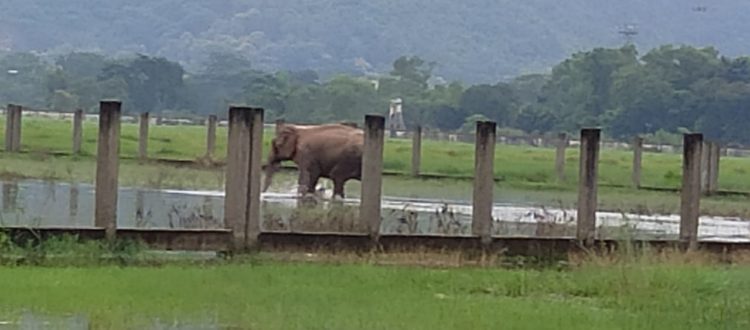WTI-IFAW-Assam Forest Department team rescues flood swept elephant in Assam
Dakhalaghat, 17 July 2020:
In a very challenging flood rescue this month, WTI – IFAW and Assam State Forest Department team, captured an injured and distressed female elephant from a village and released her back to the wild.
The first reports of this adult elephant swimming downstream in Brahmaputra from eastern or central Assam, negotiating raging floodwaters came on the 10th of July. She continued her struggle against the torrential current taking her further downstream. The elephant was first spotted near Orang National Park.
By 12th July, the elephant was spotted again at Dakhalaghat (about 100 km from Orang National Park)- a thickly populated low lying swampland with one hillock. The distressed elephant’s behaviour had the local populace worried. The Assam Forest Department constituted a committee to conduct a rescue operation.
“For this particular rescue, the state government had constituted a committee which requested the IFAW-WTI wildlife rescue team to handle this situation”, mentioned Dr Rathin Barman, In-Charge of the IFAW-WTI-AFD run Centre for Wildlife Rehabilitation and Conservation (CWRC). Dr Bhaskar Choudhary Head veterinarian of WTI was immediately called in to join from Manas National Park.
On the 14th afternoon, Dr Bhaskar Choudhary joined the Assam Forest Department team in their rescue efforts. The team noted that the adult female elephant had developed mammary glands indicating that she was a lactating mother and her left eye was completely damaged as well. The team surmised that during river crossing she may have separated from her calf and was swept almost 250 km downstream.
Dakhalaghat’s lowland swampy area is irrigated with the numerous streams of Brahmaputra, and the villages here are partly submerged in floodwaters. Chemical capture, was a calculated risk but a risk that had to be taken as the distressed elephant had started damaging standing crops, shops, and houses in the area. People already affected by flood and COVID-19 restrictions were getting tense and the team had to act swiftly.
[acx_slideshow name=”elephantstory”]
Evacuations of three villages were initiated the same day to eliminate the possibility of any casualty during the capture. However, the first attempt to capture didn’t succeed as the elephant had gone too close to the river and remained there till late evening. The joint team then arranged for three trained captive elephants (kumkis) to escort and help in restricting her from going into deep swamps post darting as she could risk drowning under the effect of anaesthetics.
The next day, on the 15th of July, when the elephant was still inside the swamp, the team attempted to restrict her within a few warehouse campuses near the swamp but were again unsuccessful. Megafauna capture and rescue requires immense patience and planning and even backup planning, the joint team of WTI-IFAW-AFD knew this and waited till it was safe to make another attempt. Meanwhile Dr Prabhat Basumatary from Manas National Park also joined in to strengthen the team.
On the 16th morning, she was spotted next to a few warehouses and empty land plots with brick walls. Another attempt to dart it was made getting as near as possible and under the cover of the brick walls. This was successful and with the animal finally under full sedation, she could be physically restrained with ropes. The biggest hurdle facing the team at this juncture was getting logistics to lift and load the sedated elephant. An earth excavator was somehow requisitioned to clear the path for the extraction and some brick walls had to be broken down by this excavator to this purpose.
The capture and loading took 5 hours during which the Zoo team of four – Mr Sunil Teron, Md Abed Ali, Md Romiz and Mr Priyakanta Borbora – carried out the tough exercise of securing, lifting and unloading and release supervised by the Vet team. IFAW-WTI team ensured that she remained sedated through this period to the release site. They reached the location of release at 6:15 pm and had to brave protests from locals, who had to be placated.
She was finally released in the Rani Reserve Forest which is about 25km from the capture location. She initially stood for a good 5-7 minutes, gathering her strength, before slowly walking through a small stream into the Rani Reserve Forest.
“It’s a mixed feeling, a mother losing her calf, being blinded in one eye, separated from her herd and released about 250 km from her home range. But that’s the best we could do in these circumstances. She has been released in her natural habitat, where she will make new friends of her ilk and adapt to her new home” surmised Dr Bhaskar.
Follow our updates on #AssamFloods2020 #AssamFloods and #kazirangaFloods on Twitter, Instagram and Facebook









